
Unripe ackee fruit, Do not eat. Photo by Green Deane
The ackee pictured above is not ready to eat. In fact at this stage it can kill you. Some 5,000 people died from eating ackee between 1886 and 1950 leading to it being banned from import to the United States.

Ackee has to open (yawn) naturally to be edible.
You will find this tree either wild or intentionally cultivated in Central and South Florida also the Caribbean Islands. The toxin in the fruit is hypoglycin A, an amino acid unnatural to our bodies. It causes a severe drop in blood glucose. The arils are toxic before the fruit naturally opens called “yawing.” The seeds are always toxic. If even a tiny part of seeds are left in the ripe arils it can make you sick. The rind has saponin and is used to poison fish.
The amount of hypoglycin A in an ackee fruit usually depends on how ripe it is and if it was allowed to ripen naturally. A naturally ripened ackee fruit will have high levels of hypoglycin A in its seed and rind, but low levels in its arils. However, a green unripe ackee fruit has high levels of hypoglycin A in all its parts about 1000 parts per million. If ackee has more than 100 parts per million of hypoglycin A, It is considered unsafe to eat.
A national dish of Jamaica, if you are going to eat ackee do not eat fresh achee that has not ripened naturally. Do not cook ackee that has not ripened naturally. Do not eat the seeds or rind of any ackee. Do not prepare raw ackee unless you have been trained to do so. Make sure any frozen or canned ackee is from a U.S. government approved supplier. The raw ackee I’ve eaten tasted and smelled like a mild cheddar cheese. Some ripe ackee arils have a buttery texture and flavor.
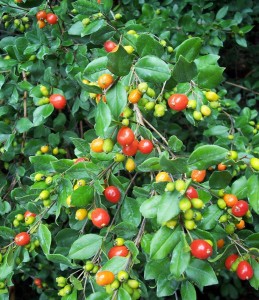
Simpon Stoppr fruit tastes similar to orange marmalade. Photo by Green Deane
The Simpson Stopper can flower and fruit anytime of year though it can favor late summer and early fall. We saw several shrubs of it in heavy fruit last week in Largo.
The fruit is edible and the leaves can be made into a tea with various application. (Usually branch tips are used.) Such infusions medicinally have been used respiratory problems, inflammations of the throat and the gums, tonsillitis, stomatitis and various yeast infections. A leaf tea was used to stop diarrhea.
In it’s native Ecuador the fruit is used to make aromatic liquor, jam, jelly and eaten as is. It is also simmered into Colada morada (strained purple) Which is a traditional drink for November 2, the Day of the Dead or All Souls Day.

Chinese elm bark, photo by Green Deane
From a foraging point of view downed oaks don’t provide much windfall. Only the ones that were masting are of interest and they were already dropping acorns. But there are a couple of tree species worth investigating if they are blown over. One is pines. It’s an opportunity to harvest cambium and or nearly ripe cones for their seeds. It’s fairly easy to strip “fillets” off downed limbs or young trunks. And one does not have to climb the tree for the cones. A second tree worth investigating is the Chinese Elm. It’s used in landscaping intensely. During the Great Depression of the 1930’s they were planted by the millions and perhaps are the most intentionally planted tree outside of the lumber industry. A windfall of this species brings not only young leaves and samaras within reach but also provides easy access to the tree’s cambium which is edible. Every tree’s cambium grows differently and is the “living”part of the tree. It grows in two directions at once, in and out. The inner cambium become the wood of the tree. The outer cambium becomes the bark of the tree. This gives each tree it’s distinction wood and bark. And on the Chinese Elm (all Ulmus actually) and the pine (all Pinus) the cambium is edible.
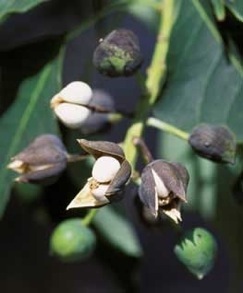 Is it edible? Yes, no, maybe… The Chinese Tallow tree is both banned and championed. It’s edibility is also linked to why it’s even in the United States to begin with. The tree was imported by none other than Ben Franklin (well… he sent some seeds to a friend.) The purpose was to use the white external seed fat for making candles which beef suet, tallow, was once used for. Hence the tree’s name in English. In theory that small coating of saturated fat on the outside of the seed is edible. It is also very stable. But there are two problems. It can be very difficult to remove and inside the seed there is an oil toxic to humans. So the fat and the oil should not mix. Some people have experimented with crushing the entire seed and heating the mash thus melting the saturated fat along with releasing the toxic oil. When they settle the edible fat and the non-edible oil separate on cooling. In China, where the tree is valued, they steam the white saturated fat off. The tree, while an invasive species in some areas of North America — such as Florida — is being considered as a good candidate for bio-fuel. You can read my article about it here about it here. A later magazine article about the species is here.
Is it edible? Yes, no, maybe… The Chinese Tallow tree is both banned and championed. It’s edibility is also linked to why it’s even in the United States to begin with. The tree was imported by none other than Ben Franklin (well… he sent some seeds to a friend.) The purpose was to use the white external seed fat for making candles which beef suet, tallow, was once used for. Hence the tree’s name in English. In theory that small coating of saturated fat on the outside of the seed is edible. It is also very stable. But there are two problems. It can be very difficult to remove and inside the seed there is an oil toxic to humans. So the fat and the oil should not mix. Some people have experimented with crushing the entire seed and heating the mash thus melting the saturated fat along with releasing the toxic oil. When they settle the edible fat and the non-edible oil separate on cooling. In China, where the tree is valued, they steam the white saturated fat off. The tree, while an invasive species in some areas of North America — such as Florida — is being considered as a good candidate for bio-fuel. You can read my article about it here about it here. A later magazine article about the species is here.
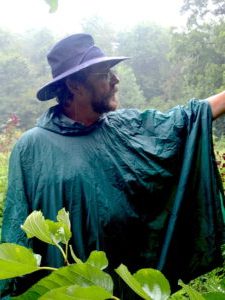
Classes are held rain or shine (but not during hurricanes.)
Foraging classes: Trying to avoid future hurricanes is a tough call and why my classes are favoring certain parst of the state on a given weekend. Heading to Gainesville and Orlando this weekend.
Sept. 30th Florida State College, south campus, 11901 Beach Blvd., Jacksonville, 32246. 9 a.m. We meet at Building A next to the administration parking lot.
Oct 1stst Mead Garden: 1500 S. Denning Dr., Winter Park, FL 32789. Meet at the bathrooms, 9 a.m.
Oct 7th Boulware Springs Park, 3420 SE 15th St., Gainesville, FL 32641. 9 a.m. Meet at the pavilion near the pump house
Oct 8th Red Bug Slough , Sarasota. 9 a.m. Because of rennovations, we have to meet at a different location at Red Bug Slough in Sarasoata. Normally it is at 5200 S. Beneva Road. Instead we will have to park at Gypsy Street and South Lockwood Ridge Road. Gypsy can be reached by Camphor Ave which runs south of Proctor west of Beneva.
Oct 14th Dreher Park, 1200 Southern Blvd., West Palm Beach, 33405, 9 a.m. meet just north of the science center.
Oct 15th Blanchard Park, 2451 Dean Rd, Union Park, FL 32817 9.a.m. met at the pavilion by the tennis courts.
For more information, the pre-pay for a class, or sign up go here.
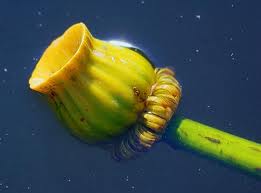 Fall is a good time to look for Yellow Pond Lilys. While they fruit rather continuously these pond residents are putting forth a crop now. Plants may not have a brain they can have a strategy, or at least so it seems. Many of them protect their seeds in various ways until they are ready to germinate. The Persimmon Tree comes to mind. The fruit is astringent until the seeds are mature enough to germinate. Then the fruit turns sweet attracting various animals to eat it — those that can taste sweet — and spread the seeds around. The Monstera deliciosa has the same saccharin strategy. The seeds are acrid until ready to germinate then they turn sweet. They have a flavor reminiscent of pineapple and/or wild chamomile. The Yellow Pond Lily works in a similar fashion, almost. It does not turn sweet but the bitterness goes away. Seeds that are not ready to germinate are bitter. As the plant dies the floating seed pod rots over a three-week period. When the seeds are ready to germinate the protective bitterness is removed by enzymatic action. This also makes the seeds edible. Of course we humans can take advantage of the system by collecting the seed pods ourselves and controlling the rotting process. Then we get the seeds and dry them for use in various ways. You can read more about the Yellow Pond Lily here.
Fall is a good time to look for Yellow Pond Lilys. While they fruit rather continuously these pond residents are putting forth a crop now. Plants may not have a brain they can have a strategy, or at least so it seems. Many of them protect their seeds in various ways until they are ready to germinate. The Persimmon Tree comes to mind. The fruit is astringent until the seeds are mature enough to germinate. Then the fruit turns sweet attracting various animals to eat it — those that can taste sweet — and spread the seeds around. The Monstera deliciosa has the same saccharin strategy. The seeds are acrid until ready to germinate then they turn sweet. They have a flavor reminiscent of pineapple and/or wild chamomile. The Yellow Pond Lily works in a similar fashion, almost. It does not turn sweet but the bitterness goes away. Seeds that are not ready to germinate are bitter. As the plant dies the floating seed pod rots over a three-week period. When the seeds are ready to germinate the protective bitterness is removed by enzymatic action. This also makes the seeds edible. Of course we humans can take advantage of the system by collecting the seed pods ourselves and controlling the rotting process. Then we get the seeds and dry them for use in various ways. You can read more about the Yellow Pond Lily here.
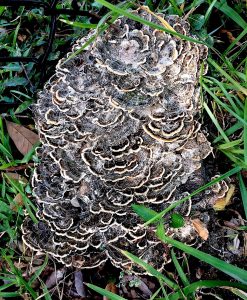
True Turkey Tails. Photo by Green Deane
Turkey Tails are fairly easy to identify medicinal mushroom. For a common type of mushroom I don’t see them that often… two or three times a year. I see False Turkey Tails far more often. More on that later. A seven-year study funded by the National Institutes of Health found Turkey Tail (Trametes versicolor) boosted the immunity in women who had been treated for breast cancer. Researchers at the University of Minnesota and Bastyr University conducted the study in women with stages I-III breast cancer who had completed radiation therapy or chemotherapy. Results showed that immune function was enhanced in the women who took daily doses of Turkey Tail in pill form. They reported that the improved immune response was dose dependent and that none of the subjects suffered any adverse effects. Trametes versicolor can be chewed whole, eaten ground, or made into a tea, or a tincture. The question that always follows such comments is are False Turkey Tails, Stereum ostrea, medicinal? Informally one hears herbalists saying False Turkey Tails can be used but there are few specifics though it has a long herbalism history. A study in 2007 found that water extracts of Stereum ostrea were antibacterial and antifungal. That’s not cancer fighting or immune system stimulating but useful nonetheless. You can read that article here.

You get the USB, not the key.
150-video USB would be a good end of spring present and is now $99. My nine-DVD set of 135 videos has been phased out. The USB videos are the same videos I have on You Tube. Some people like to have their own copy. The USB videos have to be copied to your computer to play. If you want to order the USB go to the DVD/USB order button on the top right of this page. That will take you to an order form. I’d like to thank all of you who ordered the DVD set over the years which required me to burn over 5,000 DVDs individually.

Green Deane Forum
Want to identify a plant? Perhaps you’re looking for a foraging reference? You might have a UFO, an Unidentified Flowering Object, you want identified. On the Green Deane Forum we — including Green Deane and others from around the world — chat about foraging all year. And it’s not just about warm-weather plants or just North American flora. Many nations share common weeds so there’s a lot to talk. There’s also more than weeds. The reference section has information for foraging around the world. There are also articles on food preservation, and forgotten skills from making bows to fermenting food.
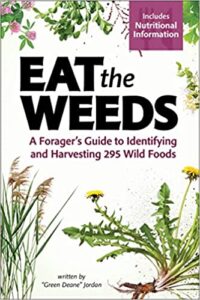 Now being printed is EatTheWeeds, the book. It should have 275 plants, 350-plus pages, index and color photos. Several hundred have been preordered on Amazon. And it is being printed as I write. Most of the entries include a nutritional profile. Officially it will be published October 5th (to suit the publisher publicity demands) and apparently to appeal to the winter market.
Now being printed is EatTheWeeds, the book. It should have 275 plants, 350-plus pages, index and color photos. Several hundred have been preordered on Amazon. And it is being printed as I write. Most of the entries include a nutritional profile. Officially it will be published October 5th (to suit the publisher publicity demands) and apparently to appeal to the winter market.
This is weekly newsletter #574. If you want to subscribe to this free newsletter you can find the sign-up form in the menu at the top of the page.
To donate to the Green Deane Newsletter click here.

